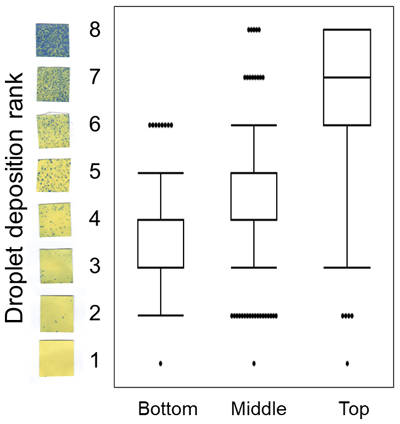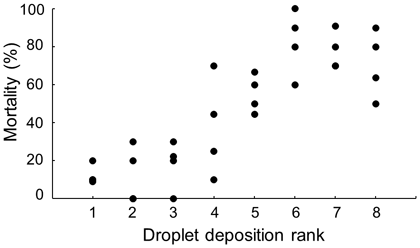Current status of insecticide use by farmers for controlling rice planthoppers in the northern part of Vietnam
Description
Insecticides are widely used in Asia to control insect pests on rice such as the rice planthoppers Nilaparvata lugens and Sogatella furcifera. It has been known that these species developed resistance against several insecticide ingredients, resulting in difficulty to control. They migrate from the central and northern parts of Vietnam to Southern China and Japan every year but are unable to overwinter in the immigrated areas. Hence, insecticide use in the source areas is a key factor when considering insecticide resistance management. Here we investigated the situation of insecticide use by local rice farmers and the effect of insecticide application to the density of planthoppers in the northern part of Vietnam.
Interviews with rice farmers revealed the active ingredients used in the paddy fields. Ten groups consisting of 21 ingredients were confirmed in two villages in Nam Dinh and Vinh Phuc Provinces, with the differences noted among locations and crop seasons (Table 1). Generalized linear model analysis was performed, with locations, crop seasons, the applied number of insecticide ingredients, and the number of spiders and mirid bugs (the natural enemies of planthopppers) as explanatory variables, and the planthopper density at booting stage as response variable. The results indicated that the applied number of ingredients has a weak effect in reducing the density of planthoppers (Table 2). Pesticide application using knapsack sprayers was evaluated using water-sensitive papers (WSPs). Droplet depositions on WSPs were high at the top part of the rice plant (height above the water surface ≈ 60 cm), moderate at the middle part (40 cm) where S. furcifera lives, and low at the bottom part (15 cm) where N. lugens lives (Fig. 1). The mortality of adult female N. lugens was high when the droplet deposition rank was high (Fig. 2), implying that one of the factors for the weak effect of insecticide application by farmers was that insecticide droplets did not reach the targets’ habitats.
The results indicated that improving the method of pesticide application, i.e., enabling the droplets to reach the planthoppers’ habitat, will efficiently control rice planthopper because, in general, systemic insecticides are rarely transferred from the top to the bottom of the plant. Insecticide resistance development is probably another reason for the lower efficiency in pest control. Vietnamese planthopper population needs to be monitored for insecticide resistance.
Figure, table
-
Table 1. Insecticide ingredients used by farmers in two villages in Northern Vietnam
Group Active ingredients Nam Dinh Vinh Phuc Winter (38) Summer (38) Winter (37) Summer (26) Average frequency of spraying the active ingredients/field 4.48 8.83 0.29 1.88 Carbamates BPMC - - - ○ Organophosphates Chlorpyrifos ○ - - ○ Chlorpyrifos-ethyl ○ ○ - ○ Quinalphos ○ ○ - - Phenylpyrazoles Fipronil ○ ○ ○ ○ Pyrethroids Cypermethrin ○ ○ - ○ Permethrin - ○ - ○ lambda-Cyhalothrin ○ - - - alpha-Cypermethrin ○ ○ - - Neonicotinoids Imidacloprid ○ ○ - - Nitenpyram ○ - - - Acetamiprid - ○ - - Dinotefuran - ○ - - Thiamethoxam - - ○ ○ Avermectins Abamectin ○ ○ - ○ Emamectin benzoate ○ ○ - ○ Pyridine azomethine derivatives Pymetrozine ○ ○ ○ - Nereistoxin analogues Thiosultap-sodium - ○ - - Buprofezin Buprofezin ○ ○ - - Oxadiazines Indoxacarb ○ ○ - - Diamides Chlorantraniliprole - ○ ○ ○ Active ingredients were classified by the Insecticide Resistance Action Committee. The number in the parenthesis is the number of farmers interviewed.
-
Table 2. Results of generalized linear model analysis on variables affecting the density of rice planthoppers
Explanatory variables d.f. Estimated value χ2 p value Location 1 0.63 4296.03 <0.001 Crop season 1 -0.31 662.63 <0.001 Applied number of ingredients 1 0.02 22.47 <0.001 Number of spiders 1 0.02 4534.75 <0.001 Number of mirid bugs 1 0.06 6285.56 <0.001 -
Fig. 1. Droplet deposition ranks at different heights of the rice plant
-
Fig. 2. Relationship between the droplet deposition rank and mortality of N.lugens
Dots show the mortality for each replicate. Insecticide contains 45% nitenpyram, 25% pymetrozine, and 5% imidacloprid (w/w).
- Affiliation
-
Japan International Research Center for Agricultural Sciences Crop, Livestock and Environment Division
- Classification
-
Technical A
- Research project
- Program name
- Term of research
-
FY2019 (FY2016-FY2020)
- Responsible researcher
-
Matsukawa Mizuki ( Crop, Livestock and Environment Division )
KAKEN Researcher No.: 50782637Kobori Youichi ( Crop, Livestock and Environment Division )
Nguyen Huy Chung ( Plant Protection Research Institute )
- ほか
- et al.
- Publication, etc.
-
https://doi.org/10.1584/jpestics.D18-080
Matsukawa-Nakata et al. (2019) Journal of Pesticide Sciences, 44(2):129-135
https://doi.org/10.1007/s13355-019-00641-1Matsukawa-Nakata et al. (2019) Applied Entomology and Zoology, 54(4):451-457
- Japanese PDF
-
2019_B07_A4_ja.pdf838.96 KB
2019_B07_A3_ja.pdf252.39 KB
- English PDF
-
2019_B07_A4_en.pdf113.87 KB
2019_B07_A3_en.pdf205.28 KB
- Poster PDF
-
2019_B07_poster_fin.pdf269.77 KB


